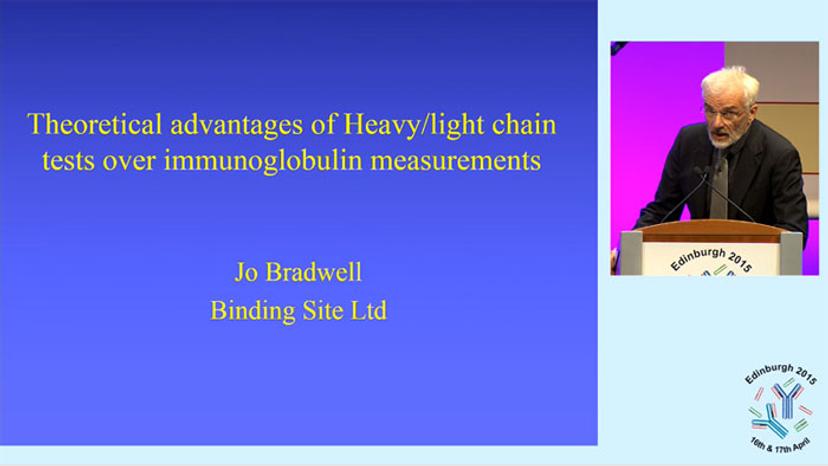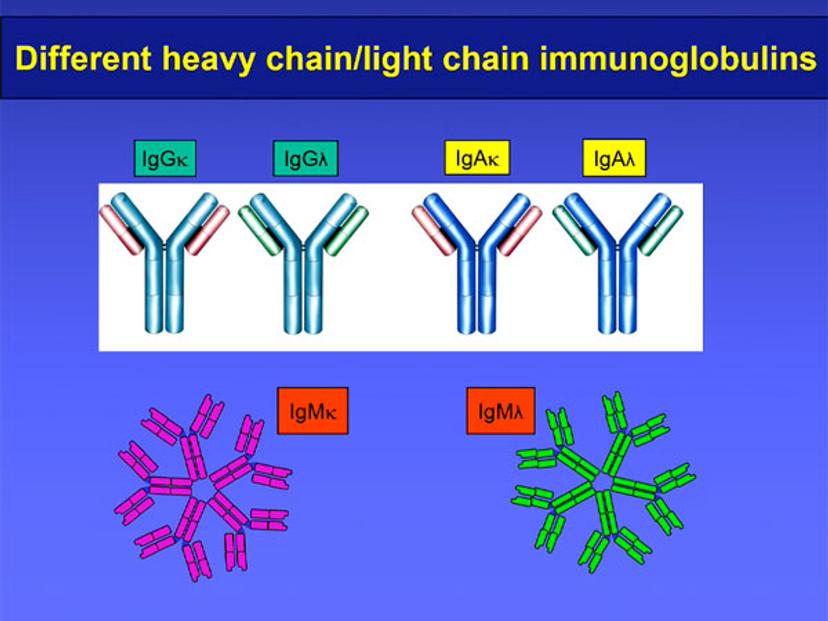Theoretical Advantages of Heavy/Light Chain (HLC) Tests over Immunoglobulin Measurements
How heavy/light chain assessment overcomes the limitations of traditional assays for intact immunoglobulin multiple myeloma
10 Jun 2015

Professor Jo Bradwell, Honorary Professor of Immunology, University of Birmingham, UK
Professor Jo Bradwell Jo Bradwell is an Honorary Professor of Clinical Immunology in the Division of Immunity and Infection. Jo is currently involved in clinical trials with patients who have Multiple Myeloma and are in renal failure.
At Binding Site’s recent 7th International Symposium on Clinical Applications of Free Light Chain and Heavy/Light Chain Analysis, Professor Jo Bradwell gave a presentation on the theoretical advantages of heavy/light chain analysis over traditional immunoglobulin measurement.
For Multiple Myeloma monitoring, monoclonal immunoglobulins have traditionally been identified using serum protein electrophoresis (SPE) with scanning densitometry, nephelometry and/or immunofixation electrophoresis (IFE).
Assay sensitivity
SPE is an easy, low cost test, but it has low sensitivity. A common problem with SPE is the co-migration of monoclonal immunoglobulin A (IgA) and serum proteins in the β region such as transferrin, an iron-binding protein present in plasma. This co-migration makes it impossible to accurately quantify the amount of monoclonal immunoglobulin present by densitometry due to overlapping or obscured peaks.

Co-migrating IgA myeloma samples including 3 with no monoclonal band detected by SPE
Improved sensitivity can be achieved with IFE, but this is a non-quantitative assay. Total IgA may also be measured using nephelometry; however, the disadvantage of this test is that it cannot distinguish between monoclonal IgA (IgA kappa (κ) or IgA lambda (λ)) and the polyclonal background IgA.
Intact immunoglobulin measurement
Measuring intact immunoglobulin in the serum is important for the monitoring of Multiple Myeloma and the detection of residual disease. Intact immunoglobulins contain unique junctional epitopes between the heavy and light chains. These are the targets used to make highly sophisticated polyclonal antibodies that will identify, separately, IgGκ, IgGλ, IgAκ, IgAλ, IgMκ and IgMλ. Targeting six amino acids in total for each Hevylite® test (three on the light chain and three on the heavy chain) ensures antibody specificity is high. The molecules are assessed in pairs i.e. IgGκ/IgGλ, IgAκ/IgAλ, IgMκ/IgMλ to produce heavy/light chain ratios in the same manner as the serum κ/λ free light chain ratios produced when using Binding Site's Freelite™ assay.

Ratio advantages
There are significant diagnostic advantages to using a ratio over serum concentrations of the monoclonal immunoglobulin. Serum concentrations measured by traditional methods may be falsely low due to plasma cell volume changes which do not affect the Hevylite® heavy/light chain ratio. Serum monoclonal immunoglobulin G (IgG) assessments can also be unreliable, as variable catabolism by FcRn recycling receptors that bind albumin and IgG become saturated or reduced by chemotherapy. This increases the half-life of IgG at low concentrations, meaning that serum IgG levels relate poorly to tumor mass and can give a false impression of patients being in deep remission (a monoclonal immunoglobulin electrophoresis band lingers when serum monoclonal protein is no longer being produced by the tumor). FcRn receptors in the kidney also partially digest intact immunoglobulin to produce fragments of free light chains in the urine, when again in fact there is no monoclonal free light chain in the serum, thus giving a false positive urine result.
In summary, during his presentation, Prof. Bradwell discussed the potential benefits of heavy/light chain measurements for the monitoring of Multiple Myeloma and the assessment of patient relapse. Traditional methods of measurement, SPE, IFE and nephelometry, are lacking in sensitivity and are not optimal methods for assessing levels of monoclonal intact immunoglobulin in serum. Heavy/light chain measurements target specific epitopes on the intact immunoglobulin, allowing measurement of individual heavy/light chain types for the first time. The Hevylite® assay produces a ratio that is not affected by low plasma concentrations or FcRn receptor metabolism, to effectively and sensitively monitor Multiple Myeloma patients and detect minimal residual disease.
Watch Professor Bradwell's full presentation here.
